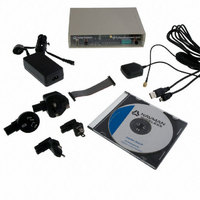AA003257-G Navman Wireless, AA003257-G Datasheet - Page 7

AA003257-G
Manufacturer Part Number
AA003257-G
Description
DEV KIT FOR JUPITER 32XLP
Manufacturer
Navman Wireless
Type
Receiver, GPSr
Specifications of AA003257-G
Frequency
1575.42MHz
For Use With/related Products
Jupiter 32 XLP
Lead Free Status / RoHS Status
Lead free / RoHS Compliant
Other names
943-1001
Available stocks
Company
Part Number
Manufacturer
Quantity
Price
Company:
Part Number:
AA003257-G
Manufacturer:
Navman Wireless
Quantity:
135
2.10 Marking/Serialisation
The Jupiter 32 xLP supports a 2D barcode indicating the unit serial number below. The Navman
13-character serial number convention is:
3.0 Performance characteristics
3.1 TTFF (Time To First Fix)
TTFF is the actual time required by a GPS receiver to achieve a position solution. This
specification will vary with the operating state of the receiver, the length of time since the last
position fix, the location of the last fix, and the specific receiver design.
Aiding is a method of effectively reducing the TTFF by making every start Hot or Warm.
3.2 Acquisition times
Acquisition time is also affected by strength of the signal received, as per the tables below. Table
3-1 shows the corresponding TTFF times for each of the acquisition modes.
LA000267D © 2008 Navman Wireless OEM. All rights reserved. Proprietary information and specifications subject to change without notice.
3.1.1 Hot start
A hot start results from a software reset after a period of continuous navigation, or a return
from a short idle period (i.e. a few minutes) that was preceded by a period of continuous
navigation. In this state, all of the critical data (position, velocity, time, and satellite
ephemeris) is valid to the specified accuracy and available in SRAM. Battery backup of the
SRAM and RTC during loss of power is required to achieve a hot start.
3.1.2 Warm start
A warm start typically results from user-supplied position and time initialisation data or
continuous RTC operation with an accurate last known position available in memory. In this
state, position and time data are present and valid but ephemeris data validity has expired.
3.1.3 Cold start
A cold start acquisition results when either position or time data is unknown. Almanac
information is used to identify previously healthy satellites.
characters 1 and 2: year of manufacture (e.g. 06 = 2006, 07 = 2007)
characters 3 and 4: week of manufacture (1 to 52, starting first week in January)
character 5: manufacturer code
characters 6 and 7: product and type
character 8: product revision
characters 9-13: sequential serial number
re-acquisition (<10 s obstruction)
Table 3-1: Acquisition times at –125 dBm
warm start TTFF
cold start TTFF
hot start TTFF
Mode
500 ms
Typ
31 s
33 s
@ –125 dBm
1 s
90%
<1 s
36 s
38 s
























